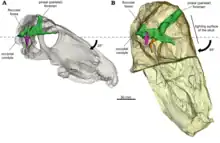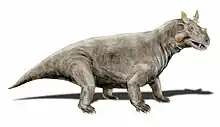| Moschognathus Temporal range: Middle Permian, Capitanian ~ | |
|---|---|
| Scientific classification | |
| Domain: | Eukaryota |
| Kingdom: | Animalia |
| Phylum: | Chordata |
| Clade: | Synapsida |
| Clade: | Therapsida |
| Suborder: | †Dinocephalia |
| Family: | †Tapinocephalidae |
| Genus: | †Moschognathus Broom, 1914 |
| Species: | †M. whaitsi |
| Binomial name | |
| †Moschognathus whaitsi Broom, 1914 | |
| Synonyms | |
| |
Moschognathus is an extinct genus of dinocephalian therapsid in the family Tapinocephalidae. The genus includes only the type species M. whaitsi, named by palaeontologist Robert Broom in 1914. It was a short-snouted tapinocephalid, closely related to and resembling the well-known genus Moschops, but its skull is less thickened overall has a relatively longer and shallower snout by comparison. Indeed, Moschognathus has typically been regarded as a junior synonym of Moschops (e.g. by King, 1988 and Atayman et al., 2009)[2][3] since 1969 after Lieuwe Dirk Boonstra sunk Moschognathus into Moschops, albeit retained as its own doubtfully valid species.[4] However, researchers in the 21st century have expressed doubt over this synonymy and suggested that Moschognathus is a distinct taxon after all, including first by Christian Kammerer in a 2009 Ph.D. thesis and formally in 2015 by Alessandra D. S. Boos and colleagues (including Kammerer) in 2015.[1] Moschognathus has since began to re-enter scientific literature of dinocephalians as a valid name and treated distinct from Moschops.[5]

The holotype specimen, AMNH FARB 5602, is a partial skeleton including the upper jaw tips, mandibles, vertebrae (including a complete cervical series from the neck), ribs, and the right pelvis and femur.[1] In addition to the holotype specimen, a complete skull and mandibles have tentatively been assigned to Moschognathus. This specimen, AM 4950, was initially identified as a juvenile Anteosaurus prior to preparation,[6] but was subsequently identified as a subadult Moschops by Julien Benoit and colleagues in 2016 and again in 2017.[7][8] This skull was argued to belong instead to Moschognathus in a Ph.D. thesis by Saniye Neumann, and this proposal was formally adopted in subsequent literature.[5][9]
References
- 1 2 3 Boos, A.D.S.; Kammerer, C.F.; Schultz, C.L.; Paes Neto, V.D. (2015). "A tapinocephalid dinocephalian (Synapsida, Therapsida) from the Rio do Rasto Formation (Paraná Basin, Brazil): Taxonomic, ontogenetic and biostratigraphic considerations". Journal of South American Earth Sciences. 63: 375–384. Bibcode:2015JSAES..63..375B. doi:10.1016/j.jsames.2015.09.003.
- ↑ King, G. M. (1988). Anomodontia. Encyclopedia of paleoherpetology, part 17C. Gustav Fischer. pp. 1–174. ISBN 0895742500.
- ↑ Atayman, S.; Rubidge, B.S.; Abdala, F. (2009). "Taxonomic re-evaluation of tapinocephalid dinocephalians" (PDF). Palaeontologia africana. 44: 88–90. hdl:10539/17294.
- ↑ Boonstra, L.D. (1969). "The fauna of the Tapinocephalus zone (Beaufort Beds of the Karoo)". Annals of the South African Museum. 56 (1).
- 1 2 Benoit, J.; Kruger, A.; Jirah, S.; Fernandez, V.; Rubidge, B. S. (2021). "Palaeoneurology and palaeobiology of the dinocephalian therapsid Anteosaurus magnificus" (PDF). Acta Palaeontologica Polonica. 66. doi:10.4202/app.00800.2020.
- ↑ Modesto, S.P.; Rubidge, B.S.; de Klerk, W.J.; Welman, J. (2001). "A dinocephalian therapsid fauna on the Ecca-Beaufort contact in Eastern Cape Province, South Africa". South African Journal of Science. 97: 161–163.
- ↑ Benoit, J.; Manger, P.R.; Fernandez, V.; Rubidge, B.S. (2016). "Cranial Bosses of Choerosaurus dejageri (Therapsida, Therocephalia): Earliest Evidence of Cranial Display Structures in Eutheriodonts". PLOS ONE. 11 (8): e0161457. Bibcode:2016PLoSO..1161457B. doi:10.1371/journal.pone.0161457. PMC 4993441. PMID 27548428.
- ↑ Benoit, J.; Manger, P.R.; Norton, L.; Fernandez, V.; Rubidge, B.S. (2017). "Synchrotron scanning reveals the palaeoneurology of the head-butting Moschops capensis (Therapsida, Dinocephalia)". PeerJ. 5: e3496. doi:10.7717/peerj.3496. PMC 5554600. PMID 28828230.
- ↑ Benoit, J.; Norton, L. A.; Jirah, S. (2023). "The maxillary canal of the titanosuchid Jonkeria (Synapsida, Dinocephalia)". The Science of Nature. 110 (4). 27. doi:10.1007/s00114-023-01853-w. PMC 10241669. PMID 37272962.

